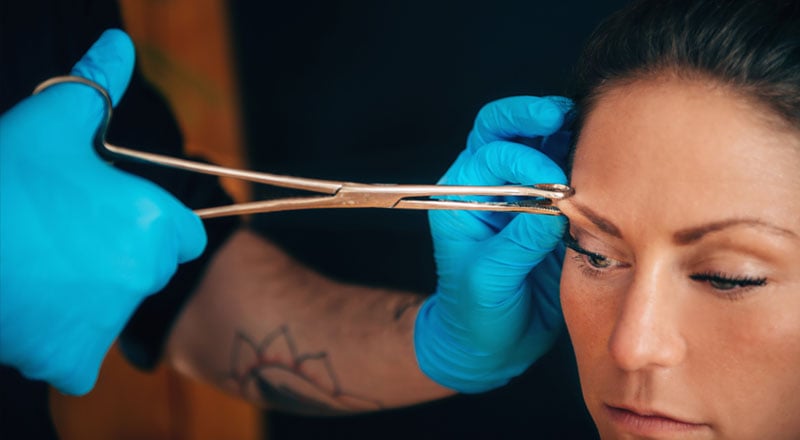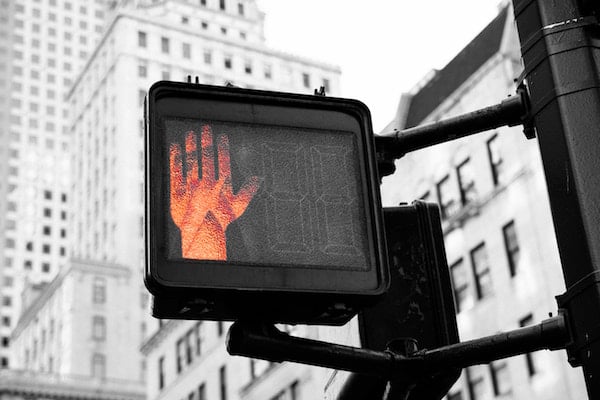By Meghan O'Neal
09/30/2019

If you’ve never been pierced before, it can be intimidating. Not only does the thought of poking a hole in the body seem painful, the entire procedure feels quite medical, which can be a little unnerving.
To help minimize your nervousness, it’s important that you know what to expect. Here’s a brief guide to how a body piercing is done.
Before you sit in the piercer’s chair, it’s up to you to find a great studio. While many piercing infections are contracted from poor aftercare practices, dirty equipment could also pass harmful microbes into your piercing, so you want to make sure that the studio is clean. Beyond that, your piercing needs to be placed correctly to avoid piercing rejection, and you want a piercer who will make you feel comfortable, especially if you’re nervous.
Go scope out the studio before you make an appointment. Ask the employees how they sterilize their equipment (it should be done in an autoclave sterilizer) and what certifications they have (they should have updated bloodborne pathogen training at the very least, and it’s always a bonus if they’re part of the Association of Piercing Professionals). They should also have a portfolio of past work that they can show you.
While some piercings, like lobe piercings, can be worn by everyone, there are some piercings that certain anatomies won’t allow. There needs to be enough flesh for the piercing to be placed deeply enough, and you need to listen to your piercer if they say it can’t be done. They might offer an alternative instead.
Using a cotton swab and disinfectant, your piercer will fully clean the area. Before they do this, they should wash their hands and don clean disposable gloves, ensuring that they aren’t introducing their bacteria to the area that’s about to be pierced.


This is an imperative step. Once your piercing is placed, it can’t be undone, so you need to check and double-check that the marked location is where you want to be pierced. Keep in mind that even a millimeter can completely change the look of the piercing, so don’t be afraid to be picky. A good piercer will be patient and understand the importance of placement.
This is when it’s a good idea to bring a friend who you trust as an extra pair of eyes. They’ll work with you and the piercer, and between the three of you, you should find the perfect placement before going through the piercing process.
Just like any medical procedure, your piercer should tell you what you’re about to go through. They’ll tell you what instruments they’ll use, the pain you might feel, how you should breathe, and ways you can minimize your pain.
If they don’t start telling you, then feel free to ask. It can sometimes help to visualize what’s happening rather than being left to guess when they’re about to poke a hole in your body. If it’s your first time, let them know, and they’ll likely give you more guidance.

The actual piercing process varies a little bit depending on the piercing location, but the basic process is the same.
Your piercer will either use a clamp to pinch the skin that’s about to be pierced or do it freehand. This depends upon your piercer’s preference and the location of the piercing. The clamp shouldn’t stay on your skin for too long; it’s only there to ensure that the piercing takes place in the right location.
Finally, the needle is poked through the skin to complete the piercing. There are three types of needles commonly used in piercings. If a hollow needle is used, the needle will go straight through the skin with the jewelry following immediately behind for one smooth movement. A cannula needle is one encased in plastic tubing. After the needle goes through, the plastic tubing remains until the piercer slips the jewelry through. If you’re getting pierced in a hard-to-reach area, like the daith or other areas of the cartilage, then you might be pierced with a curved needle. The curvature of the needle allows for easier access for the piercer.
They should give you fairly detailed instructions about how to take care of your piercing as it heals. They might also offer their preferred aftercare products for you to purchase with instructions on how to use them.
Check with your piercer to see their policy on aftercare consultation. Most piercing studios will be willing to check your piercing to see if it’s completely healed, and they’ll offer to change your starter jewelry to something smaller once the swelling has gone down. It’s always preferable to have a piercer who will offer consultations throughout aftercare so that you can be sure that your piercing has fully healed before stopping aftercare practices.
It’s your responsibility to make sure that your piercing is performed safely. As you’re getting pierced, know that you always have the right to stop the procedure and leave if you feel as though things are unsanitary or unsafe. Here are some things to watch for.

Piercing guns use blunt force to push the jewelry into your skin, and they can’t be properly sterilized. They’ve been known to cause damage to the piercee, and they easily transmit bacteria and bloodborne pathogens. If your piercer comes at you with a piercing gun, even if you’re only getting your earlobes pierced, you should leave immediately.
Piercing may be seen as a casual process, but you should view it as a medical procedure. As a medical procedure, your piercer should wear clean disposable gloves at all times, and they should change those gloves every time they handle something that hasn’t been sanitized. They should wash their hands in front of you, and their tools should come in a sealed bag that they also open in front of you. Their studio should look and smell clean as well.
Piercing can be an intimate experience, especially if you’re getting pierced in more sensitive areas. If at any point, you feel as though your piercer has crossed a professional line, then you should leave. You should always feel comfortable and respected.
This goes beyond your piercer being appropriate. Your piercer should be kind and willing to answer any of your questions. They shouldn’t make you feel bad or belittled for any of your questions. After all, they’re the professional, and if it’s your first time, it’s okay for you to be a little naive. If your piercer is rude or unwilling to answer your questions, you should find another piercing professional.
Although the idea of getting a piercing may be a scary one, it’s actually easier than you might think, especially if you find an excellent piercer. Know what to expect, don’t be afraid to ask questions, and find a kind and professional piercer, and your first piercing might just be a gateway to many piercings in the future.
Still on the fence about getting a piercing? Just think about all of the cute jewelry styles! Here are some pieces for inspiration.
Leave A Comment